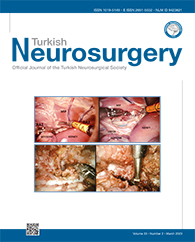2Fundación Universitaria de Ciencias de la Salud (FUCS), Research Division, Bogotá, Colombia
3University of Buenos Aires, School of Medicine, Laboratory of Microsurgical Neuroanatomy, Second Chair of Gross Anatomy, Buenos Aires, Argentina
4Hospital San Fernando, Department of Neurological Surgery, Buenos Aires, Argentina.
5Instituto de Investigación Sanitaria y Biomédica de Alicante (ISABIAL) Hospital General Universitario de Alicante, Department of Neurosurgery, Spain
6LINT, Facultad de Medicina, Universidad Nacional de Tucumán, Tucumán, Argentina
7Hospital Padilla, Department of Neurological Surgery, Tucumán, Argentina
8University of Pavia, Diagnostic and Pediatric Sciences, Department of Clinical?Surgical, Italy
9Hospital Privado de Rosario, Department of Neurosurgery, Santa Fe, Argentina
10Fondazione IRCCS Policlinico San Matteo, Neurosurgery Unit, Pavia, Italy DOI : 10.5137/1019-5149.JTN.40601-22.2 AIM: To weight the benefits and limitations of intraoperative use of micromirrors in neurosurgery.
MATERIAL and METHODS: Surgical cases where micromirrors were employed were retrospectively selected from the surgical database of five different surgeons in different hospitals. Complications directly attributable to the micromirrors were assessed intraoperatively and confirmed with postoperative neuroimaging studies.
RESULTS: Fourteen patients were selected. The site of the lesion was as follows: posterior fossa (43%), frontal lobe (22%), temporal lobe (14%), parietal lobe (7%), insula (7%), and basal ganglia (7%). Five tumors (35%) were gliomas, 3 (21%) epidermoid, and 3 (21 %) supratentorial metastases. Two patients underwent microvascular decompression for neurovascular conflict, and 1 harbored a brain arteriovenous malformation. A gross total resection was achieved in all the tumors and the AVM, while an effective decompression was successfully performed in both patients with conflict. No complications directly attributable to the use of the micromirror occurred. A relatively easy learning curve was noted.
CONCLUSION: Micromirrors proved to be useful in enhancing the visualization of neurovascular structures and pathology residuals within deep-seated surgical fields without the need for fixed brain retraction. Their cost-effectiveness and easy learning curve constitute solid reasons for advocating a revitalization of this ?old but gold? tool in neurosurgery.
Keywords : Magnification, Micromirrors, Microsurgery, Neurosurgery, Surgical mirror




